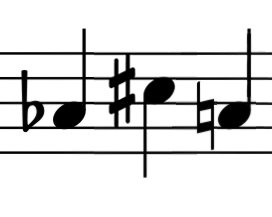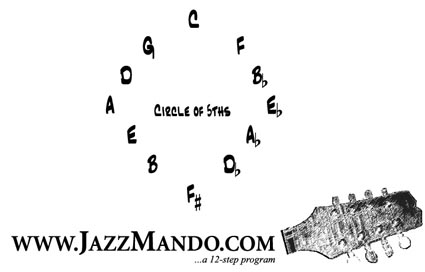« The Jazz Brain; Improv |
Main
| Improvisation: Ensemble Hatching »
 January 20, 2011 | Accidental Indicators January 20, 2011 | Accidental Indicators
We've been offering a lot of discussion surrounding the topic of 'ii V7 I' chord progressions, and this almost always includes the topic of Tonal Centers. In most common folk songs, you rarely leave a key, sometimes the whole verse of the B part of the song departs to a 4th higher, and a minor song temporarily goes to its relative major, but for the most part, we just stay put harmonically.
 It's a completely different story in jazz. We can start off in one key, take a few measures detouring into another, maybe even a third and fourth key, and that's just the A section of the song. We call these Tonal Centers, because even though in notation we don't typically indicate the small changes in keys, we certainly do aurally, and of course, in the vertical harmonic structure. It helps us immensely in our improvising to be aware of these shifts, and even though the analysis can be subjective, you can adapt your melodic (linear) vocabulary to the chord structure. You're playing along in the key of Bb major, and a temporary key change to Eb will tell you it's time to use Ab instead of A natural. It also makes you more efficient in conveying the harmonic meat of the key of Eb, the 3rds and 7ths (G and A). It's a completely different story in jazz. We can start off in one key, take a few measures detouring into another, maybe even a third and fourth key, and that's just the A section of the song. We call these Tonal Centers, because even though in notation we don't typically indicate the small changes in keys, we certainly do aurally, and of course, in the vertical harmonic structure. It helps us immensely in our improvising to be aware of these shifts, and even though the analysis can be subjective, you can adapt your melodic (linear) vocabulary to the chord structure. You're playing along in the key of Bb major, and a temporary key change to Eb will tell you it's time to use Ab instead of A natural. It also makes you more efficient in conveying the harmonic meat of the key of Eb, the 3rds and 7ths (G and A).
If we want help identifying these shifts, our ears will always be the best, but we can also look visually at notational deviations in print. Reviewing a Tips article we did in September of 2007, Part 2 of our Analysis and Microscopes series, we examined occular clues, or Accidental Indicators, simply raised notes and lowered notes.
Raised Note: (Sharp, natural in a flat key)
A sharp sign '#' will sometimes just be part of a chromatic passing tone, but the majority of the time it's an indicator we are leaving the key. It becomes the 7th scale degree or Leading tone. In the key of Bb, an E natural would hint at a move to the key of F major, because 1.) it's not in the key of Bb, and 2.) E is the 7th scale degree of the key of F major
Lowered note: (Flat, natural in a sharp key)
By the same token the note Ab in the key of Bb (notated with a 'b') might be telling you it is the 4th scale degree of the new key of Eb. First, it's not in the key of Bb, and second, it generates the strong harmonic pull of the 4th scale degree to the 3rd (Ab to G, in the key of Eb). This is a strong harmonic and melodic gravitational pull.

These indicators aren't foolproof, but they are a strong hint. If nothing else, a printed accidental notifies you visually that not only that note is changing but the chord structure as well. Of course if you're reading a fake book with chords above, this can be confirmed there, too.
Further:
Jazz Primer: Harmonic Function
Moving Forward; Melodic Progression
Tonal Centers: a hand up from Ralph Patt
'Playing musically: Part 2, play the chords
Analysis: Macroscopes and Microscopes Part 2
Posted by Ted at January 20, 2011 1:29 PM

Disclaimer: In the 'Information Age' of the 21st Century,
any fool with a computer, a modem, and an idea can
become a self-professed 'expert." This site does not
come equipped with 'discernment.'
|



